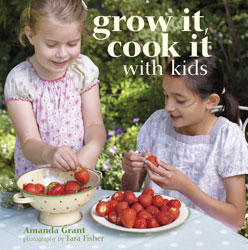Are the fruits of Mahonia x media ‘Charity’ edible, similar to Mahonia x media?
First, an aside: Mahonia has been ‘moved’ to Berberis, so that now Mahonia x media is named Berberis x hortensis, and Mahonia aquifolium is now Berberis aquifolium. Since the resources I will be quoting use the former names, I will leave them as they are.
Here’s what British author Alys Fowler says in her book, The Thrifty Forager (Kyle Books, 2011):
“All Mahonia species are edible, long-used for jams and juices in their native homes […] Sometimes you’ll find Mahonia nervosa, the Oregon grape, with the roundest grape-like berries. It looks very like Mahonia aquifolium but usually fruits later, around early autumn. […] Even when fully ripe, the acidic berries [of all Mahonia species] are too bitter to eat raw–they should be cooked into pies, jellies and jams. The flowers are edible, but bitter. The fruit needs to be picked and processed into jam or jelly very quickly, and it stains everything. It’s very low in pectin, so either add crab apples or add liquid pectin, following the usual jam making rules. You can also make an Oregon grape cordial which tastes a bit like blackcurrant cordial. Because of the low sugar content, it will need to be frozen if you want to store it–it’s a very sharp cordial, I use 350-400g (just under 1 lb) if granulated sugar to 600 ml (1 pint) of fruit. If that’s still too sharp, try mixing it with concentrated apple juice to sweeten it.”
Plants for a Future Database has pages for several Mahonia and Berberis species, including Mahonia x media, and its fruit is listed as edible.
![[Incredible Edibles] cover](https://depts.washington.edu/hortlib/graphix/incredibleedibles.jpg)
 Parents of enthusiastic young gardeners, and farmers’ market shoppers alike will love this useful guide to home-growing and cooking. It features easy, photo-illustrated recipes grouped by their main ingredients, so that chocolate zucchini cake is right next to zucchini salad and stir fry, allowing cooks to choose a recipe based on what they have on hand. Better yet, each chapter begins with step-by-step instructions for growing children’s favorites like herbs, peas, beans, and berries.
Parents of enthusiastic young gardeners, and farmers’ market shoppers alike will love this useful guide to home-growing and cooking. It features easy, photo-illustrated recipes grouped by their main ingredients, so that chocolate zucchini cake is right next to zucchini salad and stir fry, allowing cooks to choose a recipe based on what they have on hand. Better yet, each chapter begins with step-by-step instructions for growing children’s favorites like herbs, peas, beans, and berries. The authors, who are members of the San Francisco Green Schoolyard Alliance, recognize a fact that is becoming clear in schools across the country: if we are to have school gardens in this era of tightening budgets, increased academic testing and expanding class sizes, parents must step up and offer their time and energy to establish and maintain them. My own personal experience with this process as a volunteer in the garden at my neighborhood elementary school indicates that while a few parents at each school might have the necessary time and energy to devote to this, it is rare to find anyone at all with the practical knowledge, patience and understanding that are necessary to make such a garden flourish. That’s why this book is so important and useful. Not only does it empower parents and teachers to get something growing, it educates them about the planning, funding, building, maintenance, use, and enjoyment of such a garden. Valuable topics include dealing with vandalism, training students in basic garden tasks, preparing for garden lessons, scheduling class activities in the garden, and planning for summer watering. This book is a must-have for any gardening library.
The authors, who are members of the San Francisco Green Schoolyard Alliance, recognize a fact that is becoming clear in schools across the country: if we are to have school gardens in this era of tightening budgets, increased academic testing and expanding class sizes, parents must step up and offer their time and energy to establish and maintain them. My own personal experience with this process as a volunteer in the garden at my neighborhood elementary school indicates that while a few parents at each school might have the necessary time and energy to devote to this, it is rare to find anyone at all with the practical knowledge, patience and understanding that are necessary to make such a garden flourish. That’s why this book is so important and useful. Not only does it empower parents and teachers to get something growing, it educates them about the planning, funding, building, maintenance, use, and enjoyment of such a garden. Valuable topics include dealing with vandalism, training students in basic garden tasks, preparing for garden lessons, scheduling class activities in the garden, and planning for summer watering. This book is a must-have for any gardening library.